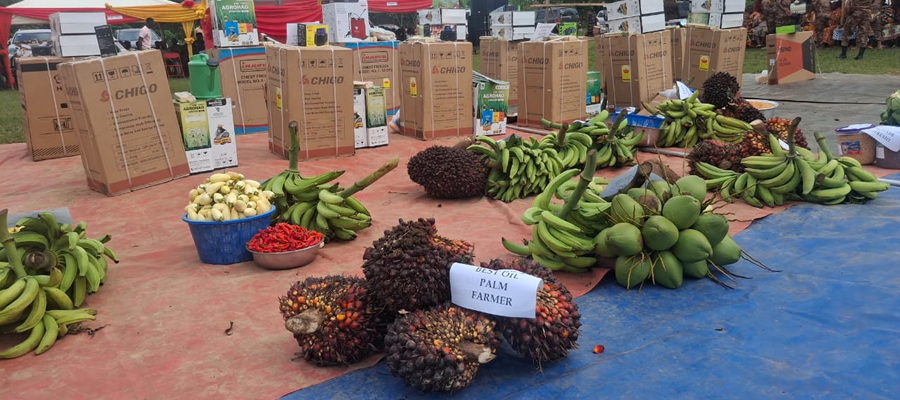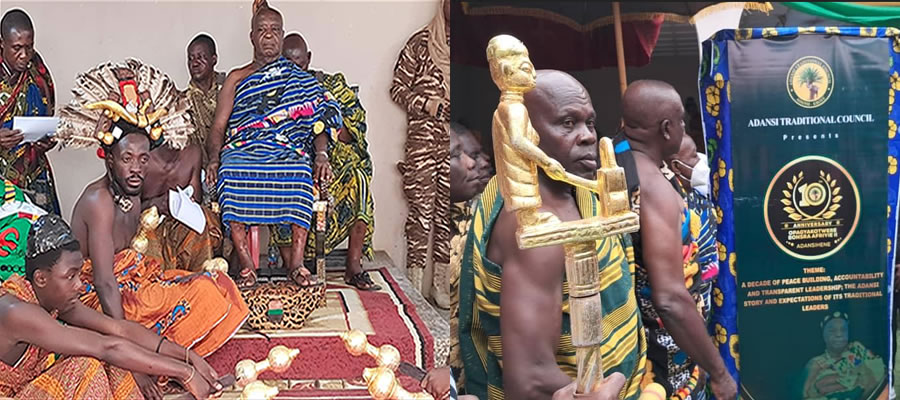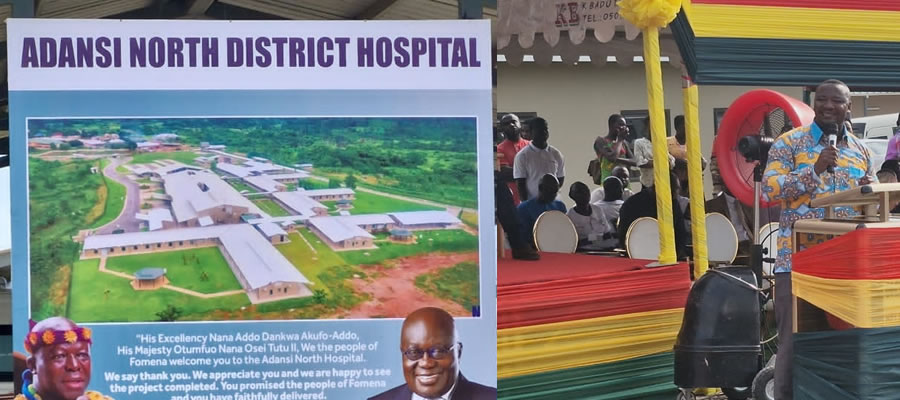

Technical Infrastructure
There is a post office and a petrol filling station located in Dompoase which serve Medoma and other communities under it and along the Kumasi – Cape Coast asphalted road. There is a post office also in Akrokerri also accessible through the Kumasi-Dunkwa road, Agogooso, Adokwai and other communities within the area along the Dompoase-Ahensan road also have access to these facilities. The post office located in Fomena serves Communities under Fomena and stretches to Ansa where the district shares a common border with the Adansi South district on the Kumasi-Cape Coast asphalted road. There is the need to have postal agencies within Fumso and Asokwa to serve Communities from Asokwa-Tasiliman road on the Asokwa-Obuasi first class road.
With the exception of Fomena and Dompoase, there are no Tele-communication services of Ghana Telecom within the major settlements. The Ghana Telecom land line existing in Fomena and Dompoase are insufficient and need to be expanded and extended to the other settlements for their rapid development. The other telecom service namely, ONE TOUCH is nonexistent. AREEBA, TIGO etc. however have their reception within some parts of the district but not encouraging. There is the need for these Telecom Companies to turn their attention to the district to ensure greater competition and service delivery. Electricity and water (Boreholes) can be found in almost all the major settlements. The provision of more potable water is ongoing. Fomena needs a mechanized water system to befit it as a District Capital.
The district has 195 schools, with 122 primary,68 junior secondary and 6 senior secondary schools, one commercial, a vocational institute and one training college. With these, 93 primary are government-owned, while the remaining 29 are for private owned. Out of the 65 junior secondary schools, 53 are owned by the public sector while the other 12 are for the private individual. There are schools built in all the major settlements. Below is a Table showing schools in the major settlements.
Adansi North District has four major hospitals and three health centres, all of which are public owned. Out of the 10 clinics in the district, three of them are for the public, while the other seven are owned by private entrepreneurs. All the dedicated maternity homes in the district are private owned. Fomena the District capital has a Health Center which needs to be upgraded into a full fledged District Hospital. Below is a Table showing Health facilities in the district, including Non functional ones.
The district can also boasts of eight banks these made of three commercial and five Rural banks .Namely the Ghana Commercial Bank, Standard Chartered Bank, Agricultural Development Bank, Adansi rural bank, Akrofuom rural bank, , Odotobiri rural bank, , Atobiase rural bank, and Mansoman Rural Bank. Several insurance companies, including State Insurance Company and Metropolitan Insurance, also operate branches in the district.
Fomena, Bodwesango and Anhwiaso are the only settlements that boast of Police Stations. Fomena the district capital is the seat of the District Police Commander. There is the need to provide Police Posts in some of the settlements to ensure peace and order. There are markets found in almost all the major settlements but Fumso has the major market which has acclaimed nationwide popularity and it needs to be developed further to attract a greater number of traders. The market in Fomena, the district capital, is not receiving the needed patronage though the infrastructure of the Market is excellent due to poor sitting of the facility and lack of parking space. There is the need to educate the people to patronize the market.
The Table above indicates the hierarchy of major settlements in the district.
The district capital Fomena is placed fourth in ranking due to the following:
1. Unemployment leading to migration of the youth.
2. Lack of credit facility to the people into Agriculture
3. Proximity of the mining Area (Obuasi)
The creation of the district and Fomena as the capital would change the face of Fomena.
The District enjoys 13 kilometres of asphalt ,69 kilometres of double surfaced and 120 kilometres of feeder roads. The Ghana Railway Corporation has 48 kilometres of railway, stretching from Akrokerri to Takyikrom, in the district.
Commodity Flows
The district is mainly an agrarian one with almost all commodities being food stuffs and other agro-based products like palm oil, palm kennel, gari cassava dough, cocoa beans etc. These commodities are mainly transported to Fumso in the district, New Edubiase, Obuasi and Bekwai in the neighbouring market centers. Again a lot of the commodities are further transported to Kumasi, the Regional Capital.
Manifestation of Levels and Locations of the Poor and Functional Regions
Adansi North District has seven (7) area councils. The capitals of each of these seven area councils have facilities that the people in the capital can take advantage of. For instance Area Council Capitals are endowed with social infrastructure such as market centres, schools, post offices etc. Thus poverty levels around these areas are not well manifested as seen in the remote parts of the areas or the hinterland of the area council. Within the remote parts of the area councils, owing to bad nature of the roads, people find it difficult to transport their food stuffs to market centres for sale. Thus their income levels are very low. Besides, family planning methods are not adopted giving way to so many births and their attendant problems.
Nature of Physical Development and Problems of Town Planning/Development Control
Almost all communities in the district are developing and growing without planning schemes. Fomena, Dompoase, Akrokerri, Asokwa, Fumso and Kwapia however have planning schemes which are too old and need to be revised. The district is therefore characterized with haphazard development patterns such as improper sitting of buildings and other facilities. Buildings are sited in most communities without access roads, and sanitation facilities.
The District faces a lot of problems with the preparation of town planning schemes in the sense that, the chiefs and elders of the various communities always complain of lack of funds for the preparation of the schemes. The District Assembly on the other hand sees the preparation of planning schemes for the various communities as the responsibility of the chiefs since they are the owners of the land and therefore, they are those who sell land or plots to prospective developers. As a result of this controversy the communities are left without planning schemes which negatively affect the development and growth of the communities.
Space Economy
Fomena, Dompoase, Akrokerri and most of the long settled areas have layouts with defined access roads. The layout of Fomena and Dompoase were prepared as far back as 1975. The towns have grown without control and therefore the layouts need to be revised.
However, some of the major settlements have no layouts and have the characteristics of slum development. Such areas include Kyekyewere/Dadwen, Asokwa, Fumso and Nyankomasu (Emphasis on Fumso / Asokwa). The main settlements in the district which need to be planned can be found underneath.
Key Development Problems and Implications
As a result of poor spatial development planning in most communities and because planning schemes have not been prepared to spearhead development planning processes, especially Kyekyewere/Dadwen and other communities, boundary disputes usually arise and threaten peace in the local economy. To forestall boundary disputes between communities, there is the need for enforcement of legal framework to ensure strict adherence to layout preparation by chiefs to avert possible breach of law by recalcitrant developers. Rampant cases of land disputes and litigation often render many good agricultural lands idle and unproductive. Under the circumstance, there is the need on the part of the District Assembly to access potential sources of funding to undertake cadastral survey of land in the district to ensure spatial development.
There is the need also to strengthen collaborating agencies like the Building Inspectorate, Town and Counting Planning Department, Development Planning and Environmental Health Unit to effectively discharge their assigned responsibilities. To facilitate orderly and planned development in the district it is suggested that with the collaborative endeavours of the Traditional Councils and the District Assembly, there should be established land banks to enable prospective developers and investors gain easy access to land.
HUMAN SETTLEMENT PATTERNS
Distribution of Roads
Roads within the district economy are measured to ensure well functioning and Communication network, which is important for improving the living conditions of the people. A number of roads traverse the district, linking up the district capital with all parts and other areas of the country. (Table 7) These include the 23 km of asphalted portion between Medoma and Ansa and the 5km double surfaced bitumen first class road between Akrokerri junction and Kyekyewere on the main Kumasi- Dunkwa road.
A number of second class and feeder roads traverse the length and breadth of the district making all areas accessible. The degree to which transport system exerts spatial influence on the district, particularly to economic activities and services cannot be over emphasized. This serves as a stimulus to the improvement and expansion of agricultural production. The Tables below show the major road network and their classification in the district. Most of the road network in the district are made up of third class roads which link most of the settlements. Owing to the fact that the third class roads have no bitumen surface, there is the need for regular maintenance.
Linkage with Other Districts
Adansi North District shares boundaries with Obuasi Municipal, Adansi South, Amansie East, and Amansie Central. By virtue of the location of the district, it has both positive and negative linkages with the other districts. On the positive side, the farming communities trade some of their farming commodities in the nearby market centres such as Obuasi, and Bekwai. Some of the inhabitants also attend hospital in places like Obuasi and Bekwai because of their proximity. On the other hand, negative impact has also been felt by the district. For instance owing to the sharing of boundaries, most energetic youth are attracted to Obuasi to find non existent jobs, thus creating low productivity in the district. This is because only the aged and the minors are left behind to undertake the farming activities in the district.
IMPLICATIONS FOR DEVELOPMENT
Settlement Systems and Linkages
Communities are scattered throughout the district. However since the district is a relatively small one with only 94 accessible communities which are not too far from the district capital Fomena, majority of the people have access to basic infrastructure for development.
Services like post office, bank, police station, electricity, markets etc. are accessible to many of the communities, and this puts the district on a spring board for accelerated development. Some of the communities in the district have access to asphalt roads since the Kumasi-Cape Coast road, passes through some of the communities in the district.
Commodity Flow
The weekly market at Fumso in the district is a major marketing centre where commodities produced in the district are sent to, for export to other districts and regions. Again, Fumso market in the district is a centre where commodities produced outside the district are imported into the district.
The market at Fumso therefore has a huge potential which when harnessed properly can help immensely in the revenue mobilization effort of the district to create jobs and wealth and to accelerate the development of the district.
Problems of town planning
None of the communities in the district has any modern and functional town planning scheme. Fomena, Dompoase, Asokwa, Fumso and few others which have planning schemes cannot use them since the schemes are too old and are very difficult to enforce their implementation. The result is that, there is uncontrolled development in most of the communities, which have resulted in slum development. Houses are haphazardly built in most communities without permit. The Assembly therefore loses revenue for development since valuation of the houses is very difficult.
6. Information, Communication and Technology (ICT)
Adansi North District Assembly is making progress in the Development of Information, Communication and Technology (ICT) and is ensuring that information technology gets to all facets of the District development especially in education and health.
In the light of the above, adequate infrastructure will be provided to both basic and the second-cycle schools within the District. The provision of Community Information Centre (CIC) at Dompoase which has 24 hour internet service for both institutions and the general public is a case in point.
ICT has the capacity to inform majority of the rural populace who are farmers on improved agricultural technology, health, gender, education and security issues.
The current trend of the concentration of ICT centers in the urban centres will be improved with the establishment of information centres in the rural areas to disseminate information on government programmes and governance issues.
COMMUNICATION
Telecommunication
In terms of communication, the district can be said to have a little below average in the distribution of the national cake. The following are some of the services provided in the district:
Postal Services
The post office is inactive as incoming and outgoing letters delay for many days before they leave or come to the post office. Some of the boxes are not lockable hence leaving letters at the mercy of thieves. Again, most of the fast and reliable services cannot be accessed due to the inactive nature of the post office.
Land or Fixed lines
Land lines or fixed lines are fairly operative in the district as it can be accessed in the major towns and villages. The district has forty-eight (48) fixed lines and other Wills system of communication.
Mobile Telecommunication
With the introduction of technology into communication in the country, there has been the emergence of some Telecommunication networks such as Areeba, Tigo, Onetouch and Kasapa. However, the district is yet to enjoy these facilities fully even though, the services of Tigo and Areeba are being enjoyed by some few communities like Fomena Dompoase Medoma and others. In order to make their services fully available to the people of the district, Areeba is constructing two antennae in the district to boost its services.
Date Created : 11/10/2017 5:40:15 AM













 facebook
facebook
 twitter
twitter
 Youtube
Youtube
 +233 593 831 280
+233 593 831 280 0800 430 430
0800 430 430 GPS: GE-231-4383
GPS: GE-231-4383 info@ghanadistricts.com
info@ghanadistricts.com Box GP1044, Accra, Ghana
Box GP1044, Accra, Ghana